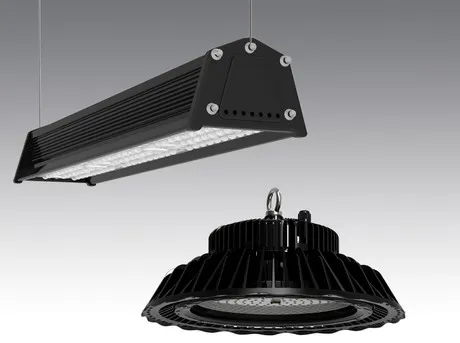Potatoes for the food industry and retail must be fresh, crisp and germ-free. Potato storage rooms should be cool, undisturbed and having the right levels of humidity and darkness. Studies and many years of experience in potato logistics show that the use of white light leads to a reduction in the quality of the goods. CONPOWER GmbH & Co. KG now offers different lighting for the potato industry.

The Helios and Korona LED indoor floodlights are the ideal lighting solution for potato processing warehouses. They have the ability to emit light in a 520-540 nm wavelength, preventing the forming of solanine / chlorophyll.
White light
The light spectrum called "white light" is composed of light waves of a large bandwidth. The spectral waves are measurable in a range between ultraviolet and infrared. Visible "white light" is composed of different light colors. Individual spectra are particularly important for plant growth. In particular, the red and blue spectral components of the light are photoactive and promote growth. This light gives the potato the spark to germinate and turn green.
Solanine and chlorophyll are formed in the potato during the germination process. The potato Solanin serves as a toxin to ward off pests. Chlorophyll leads to the green of the potato. The potatoes are not only soft and unsightly, but also inedible, because the alkaloid solanine is also toxic to humans.
LED use in the potato industry
Modern lighting technology in the form of light-emitting diodes, or LED for short, offers the potato industry new possibilities. Diodes can be coated to filter the emitted wavelengths. Thus, an exact limitation of the spectrum is possible.
The CONPOWER development team manufactures special luminaires for the potato industry with a strict selection of diodes that work in the 520-540 nm range. The light, which is green to the human eye, effectively prevents germination and thus provides a crucial factor for the value-preserving storage and processing of potatoes. Solanine and chlorophyll formation is effectively suppressed.
No greening
Independent field test of luminaires by Kartoffel Kuhn GmbH confirms the effect. "We wanted to do a test in-house, seeing what the 'green LED light' would do for our potatoes. For this experiment, we brought a pallet of potatoes into our cold room and put them under the "green LED spotlight" for about 8 days, 24 hours a day. After this, we examined the potatoes and found that no greening, i.e. no chlorophyll / solanine build-up was found on the test potatoes. The result was more than satisfactory. If the potatoes had been exposed to normal white light under the same conditions, they would, according to our many years of experience, have turned green after only two or three days, becoming unsuitable for consumption and trade. Especially for processing and long-term storage, these lights are very interesting," says company spokesman Stefan Michels from Kartoffel Kuhn.
Energy efficiency
With an efficiency of up to 145 lm/W, these special lights for use in the potato industry are just as efficient as conventional LED lights, in use for industrial applications.
For more information:
CONPOWER Betrieb GmbH & Co. KG
Semmelweisstraße 8
82152 Planegg
Phone: +49 89 4161488-70
Telefax: +49 89 4161488-71
betrieb@conpower.de
www.conpower.de
Kartoffel Kuhn Großmarkt GmbH
Gottlieb-Daimler-Straße 14
68165 Mannheim
T: +49 621 4450930
M: grossmarkt@kartoffel-kuhn.de
W: www.kartoffel-kuhn.de/
